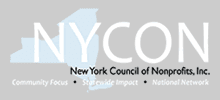The Group held their recent program meeting last Wed, April 29th, which was generously hosted by Rescue Mission. The meeting featured a panel discussion about economic impact was attended by over 25 participants. The panel featured:
- David Mathis, Director of Workforce Development
- Frank Elias, Executive Director of Mohawk Valley Chamber of Commerce
- Margaret O'Shea, CEO of The Community Foundation of Herkimer and Oneida Counties, Inc.
- Rick Sebastian, CEO of Human Technologies Corporation
- Ron Thiele, Executive Director of CNY Arts/Stanley Center for the Arts
The discussion was truly relevant and drew the attention of The Observer-Dispatch and WKTV, which both featured stories (WKTV story and OD print story). The questions (posted below) resulted in an insightful and dynamic conversation around the need for nonprofits to better communicate their impact and have a more open and collaborative discussion on the topic. As one panelist related, nonprofits can't run away from the idea of making a profit. Nothing is free and there is always a bottom-line. Nonprofits need to be clear about this cost and be viable and sustainable and state their impact.
One of the first points the panel addressed was the idea of an economic impact study for the two-county region. There was agreement in the value of such a study, and the need for it to include the financials and quality of life pieces. Peggy O'Shea related a Michigan nonprofit study, which revealed the significant contributions nonprofits make, including making up 10% of employment in the State. There was agreement that a study of the local region or across NYS could be invaluable.
The discussion continued with a key point made about how nonprofits can say they create wealth. How do nonprofit communicate in terminology and concepts that everyone understands? More importantly, how do nonprofits change the perception that they are taking away from the community? There is an attitude that if an organization isn't making money, it isn't contributing. But this isn't the case. Nonprofits are making money. For example, Ron Thiele related that the arts have a $118 million impact on the region. Take a look at the study the Central NY Community Arts Council carried out in 2002.
The discussion also focused on the need for action, and a couple of ideas were offered. One was to pick a central issue, such as health care, and collect the numbers from nonprofits (and possibly for profit companies) and lobby for change at the local and State levels. Another idea was to raise the visibility of nonprofits and their accomplishments by attending more legislature meetings. As one panelist related, nonprofits need to be speaking with government not just when there are problems or issues, but on a regular basis.
The panel agreed that there is no question about the impact of nonprofits. As one panelist mentioned, just look at inner city Utica and the buildings developed and utilized by nonprofits. The key is for nonprofits to assess what they do, and communicate their mission in terms of impact. For example, an organization should be able to say for every dollar, their impact is (fill in the blank). And if they can't communicate their impact, they may need to think about collaborations or even a merger to strengthen the organization.
Peggy O'Shea summed up the end of the meeting with a great overview of how nonprofits impact each of our lives. Her example of a young boy related how in the course of one day, his life was touched by nonprofits. From the clothing to art classes to the library to visiting a relative in a nursing home, nonprofits surround us all. As Tim Trent stated: They are the "life sector of the community." Nonprofits are not just about life in the community, they are the life of the community.
SURVEY DATA: The Economic Impact Survey Summary is available here. The data collected so far offers a beginning definition of the impact of the nonprofit community in Oneida and Herkimer Counties. For nonprofits who have not completed the survey, click here to add your data.
Feedback about the program was collected and is available to review here. The consensus was that the program was a valuable discussion, but actionable steps need to be taken now. Some participants suggested looking at the upcoming June 12th Mohawk Valley Chamber of Commerce legislators' breakfast as an opportunity.
Agree or disagree with this feedback? Want to share your thoughts? Post them here.
Panel Discussion Questions:
- 1) How do you define economic impact? How would you define the economic impact of nonprofits? Could we help nonprofits by better educating the public about their economic impact in the community?
- 2) Do you think there is value in nonprofits carrying out an economic impact study and would this information be helpful to your organization?
- 3) Have you encountered the attitude that nonprofits take funding from the community rather than giving back? How can nonprofits showcase the ways in which they generate more money for the community?
- 4) In the area of economic development and business attraction/retention, why are nonprofits not included in discussions of economic development (such as those run by EDGE)?
- 5) How can nonprofits position themselves as a vital part of the community and an asset rather than a burden?













No comments:
Post a Comment